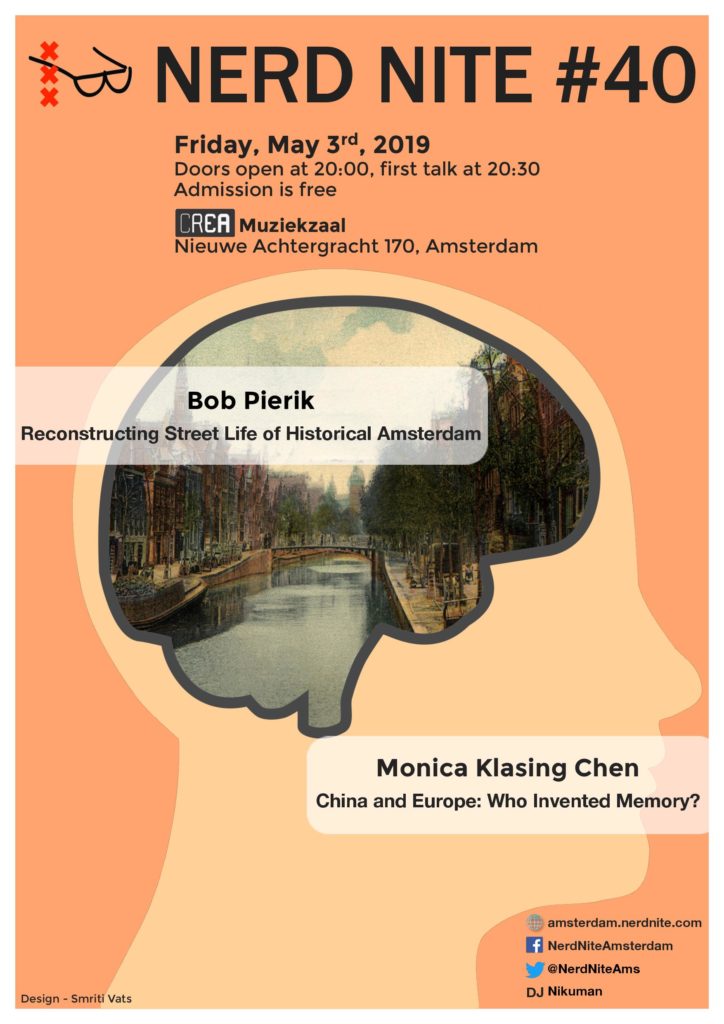Nerd Nite 40
Do you still remember the phone number of your first date? Or did you suddenly recall your first kiss when you tried a strawberry chewing-gum? Our first speaker of this Nerd Nite Monica will tell us all about memories! By looking at Chinese and European memorization techniques, she will teach us not only how to create unforgettable memories but also how society thought about them in the past. With our second speaker Bob, local Dutchman, we will unravel the past of the common folk in pre-industrial Amsterdam. But this turns out to be more difficult than one would expect as information about ordinary people is often hidden in the scraps of history. Bob will show us how he merges these scraps using modern data science.
Take this trip to the past with us on the 3rd of May and be there, be square!
DETAILS:
Friday 3rd May
Doors open at 20:00
First talk at 20:30
at CREA Muziekzaal
Nieuwe Achtergracht 170
1018 WV Amsterdam
China and Europe: Who Invented Memory?
By Monica Klasing Chen
Monica will dig into the past on both sides of the globe to find out what people thought about the act of remembering. How did people describe this process, and where in the body did it take place?
So how did our counterparts in the analogue past go about creating unforgettable memories? What techniques did they use? Most importantly, what did Chinese and Europeans find worth remembering? Find out how central it was to have a good memory and what we can learn from the past!
Bio: Monica Klasing Chen is a PhD candidate at Leiden University. She researches the use of memorization techniques in the transmission of crafts. In her spare time she practices Chinese ink painting.
Bystander history: Reconstructing everyday life in the streets of early modern Amsterdam
By Bob Pierik
Amsterdam may feel small compared to metropolises with millions of inhabitants like New York, London or Tokyo. Yet, in pre-industrial times, Amsterdam was one of Europe’s larger cities at the time, and the largest city of the Low  Countries! While there are extensive records on the city’s ruling families and their regent-patriarchs, the life of ordinary people is much more difficult to access. What actually happened in the streets of Amsterdam? This is what Bob wanted to know! Fortunately, he got help from new digital methods that rapidly open up doors into our urban past. The boundary between the social scientist that collects data and the historian that visits the archive has slowly been blurred. Let Bob take you through the streets of 18th century Amsterdam and show you how he is unearthing historical street cultures!
Countries! While there are extensive records on the city’s ruling families and their regent-patriarchs, the life of ordinary people is much more difficult to access. What actually happened in the streets of Amsterdam? This is what Bob wanted to know! Fortunately, he got help from new digital methods that rapidly open up doors into our urban past. The boundary between the social scientist that collects data and the historian that visits the archive has slowly been blurred. Let Bob take you through the streets of 18th century Amsterdam and show you how he is unearthing historical street cultures!
Bio: Bob Pierik is a historian torn between old stuff and new stuff. That is why he reads early modern manuscripts as .pdf and tries to train a computer to do paleography.

